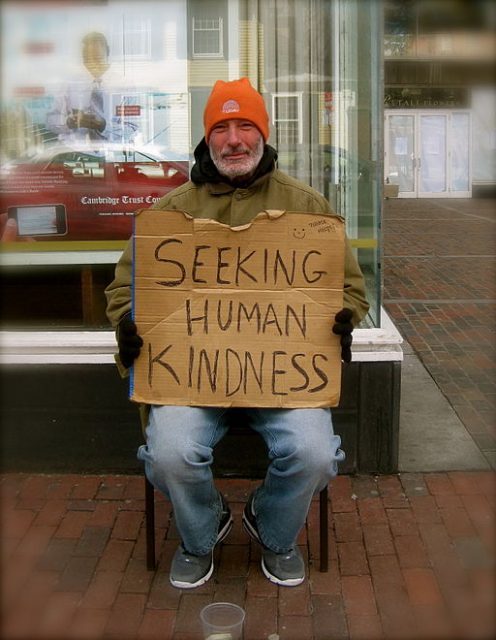
I cringe and hold my breath as a I walk past. I look, but try not to stare. I am uncomfortable—no, I am disturbed.
Were there always this many? What is happening? I am struck by the number of homeless people—pushing shopping carts overfilled with unidentified objects, digging through trash cans for scraps, begging for spare change, or laying lifeless while drooling on the sidewalk next to Whole Foods.
It is heartbreaking and baffling.
Homelessness is a systemic problem growing throughout the world as the population increases, and the reasons that ultimately cause someone to become homeless are complex. Homelessness is a result of the cumulative impact of a number of factors, rather than a single cause.
Those factors include things like the economy, drug addiction, poverty, shortage of affordable housing, and individual events.
Countries are in crisis levels of homelessness, and if we do not address this issue we will create more—more homeless, more dis-ease, more inhumanity.
How can a world so full of wealth allow human beings to live in squalor? Why do we donate to protect animals, or walk three days to raise money to find a cure for cancer, but when it comes to another human being who is homeless—we look away?
Some of our aversion to contact with homelessness can be explained by an innate desire to protect against what we think may be a communicable disease.
I admit that initially I wanted to turn away from something that isn’t pretty or easy, which is an understatement. I could let someone else do something. But, if not me—who?
I want to be part of the we who takes action, who helps—the we who help those less fortunate not only because it is humane, but because, as complex as this issue is, there is a solution.
The solution to homelessness is straightforward and simple—a concept known as Housing First.
Housing First is a concept whereby a homeless person is given housing without conditions. A person gets a place to live that allows them the basic human need of: a safe, private space to sleep, eat, and use the bathroom. It does not require participants to address chronic illness, mental health issues, or substance abuse prior to getting a permanent place to live.
When there are no conditions, a person entering permanent condition-free housing has a higher chance of staying off the streets and subsequently addressing mental health or drug addiction because he/she decides to. And, the best-case scenario is the housing is provided before the person is homeless. Guess what? It is actually less expensive to provide housing than it is to provide services after a person is homeless.
Here are a few more impressive statistics:
>> While homelessness is at a crisis rate in the European Union, one country stands apart from the rest of the EU. For 20 years, Finland’s policy is to give people homes and/or support before a person becomes homeless. While all other countries in the EU have increases in homeless rates, Finland is the only country in the EU to have a decrease.
>> In the United States, Utah’s “Housing First Initiative” resulted in a 91percent decrease of the state’s chronically homeless population.
Yes, there are criticisms of Housing First, even with its successes. It is important to note that Housing First serves best when combined with other support. As a comprehensive program, services like education, job training, job placement, mental health services, and substance abuse assistance ensure that a person can transition beyond their current homeless situation permanently.
On a recent visit to New York City (the city in the US with the highest number of homeless), I went to the Coalition for the Homeless’ office on Fulton Street to interview the location’s director.
Standing with people who lined up before 8 a.m. waiting for their names to be called for a potential home was, to put it mildly, humbling. Those waiting in line were all ages—from children to elderly—and mostly non-white. The Coalition employees were kind and welcoming to those in need, immediately offering food and smiles, and they worked to put all at ease.
It was a valuable lesson for me about the extraordinary power of humanity.
In that moment, I realized that the power of humanity—joining together to help one another, taking small steps, being of benefit, practicing kindness—can eradicate homelessness. Seeing a simple act (at the Coalition) of humans treating each other with dignity and compassion inspired me to not only write about homelessness, but also to take action.
Here are a few ways to start getting involved, taking action, and helping the homeless:
Volunteer
Find an organization to give time to. Here are a few to consider:
Homeless World Cup Foundation, PATH, or Habitat for Humanity. By joining an organization for volunteer work, we not only help the homeless but also gain insight and join together with other people who can effect change.
Vote and Support Advocacy
Use voting, calling, and email to end homelessness. The National Alliance to End Homelessness is a nonpartisan organization in the United States with tons of information including easy ways to use voting power. Click here to connect to your congress members or representatives as well as learn more about advocacy.
Donate
Donate money, goods, clothing, and/or expertise to organizations that find communal solutions to social issues like D.C. Central Kitchen, LA Kitchen, or the AIDS Healthcare Foundation. Supporting organizations translates into reaching beyond an individual impact.
Homelessness is a community issue, worldwide.
We’ve turned away from it. We’ve shaken our heads in disbelief. We’ve talked about it. Now, it is time we take action, because if we don’t the problem will only worsen and continue to grow.
And, now that we know, we can do something to end this inhumane situation, because there is a solution.
~
Author: Juli Becker
Image: Wikimedia Commons
Editor: Lieselle Davidson
Copy editor: Yoli Ramazzina

 Share on bsky
Share on bsky




Read 0 comments and reply